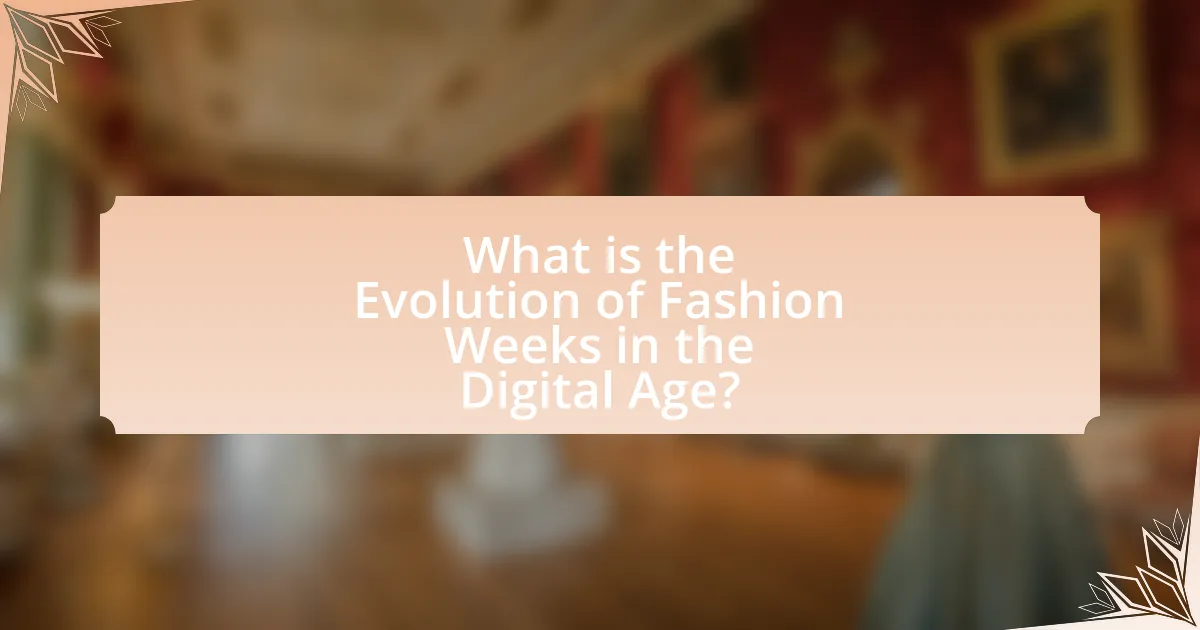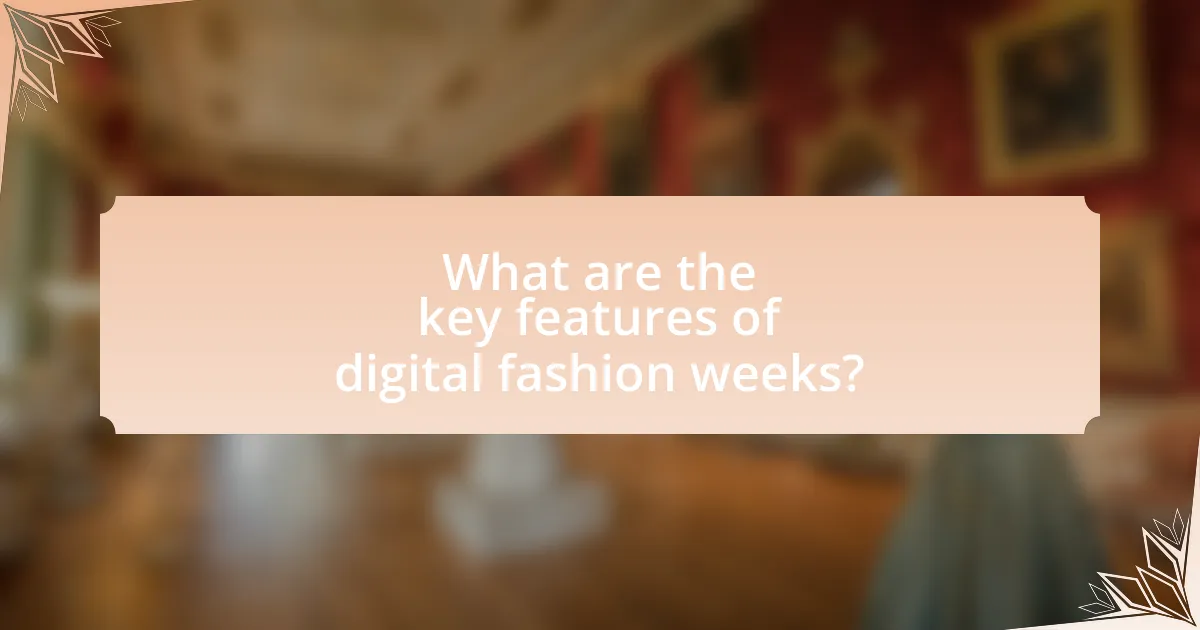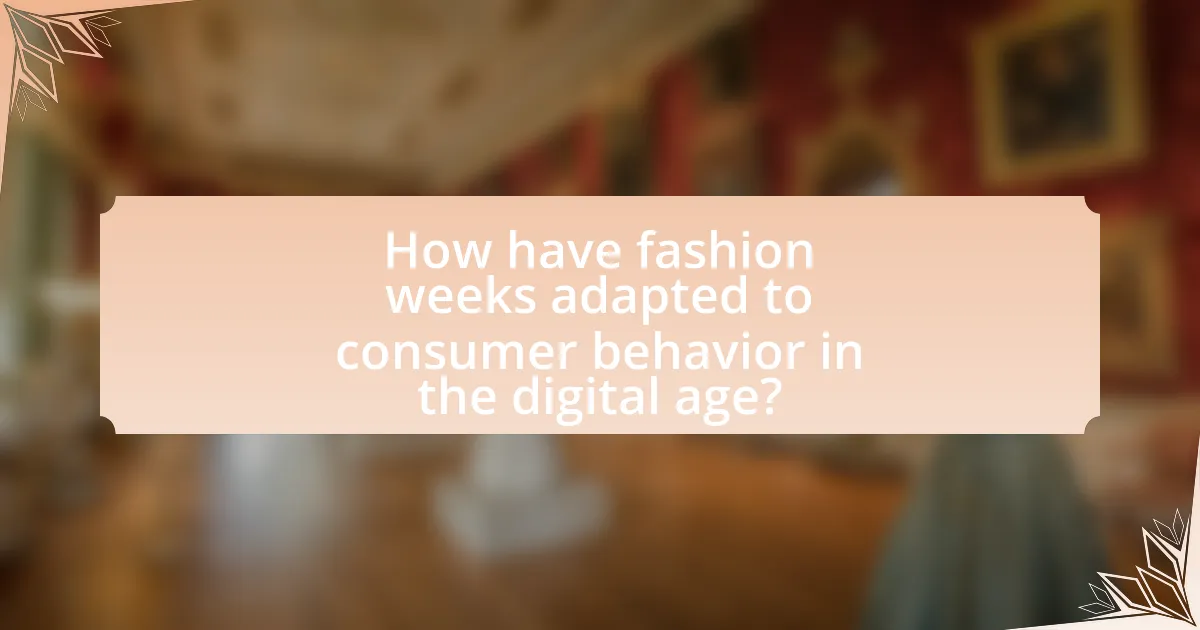The article examines the evolution of fashion weeks in the digital age, highlighting the transition from exclusive in-person events to inclusive, globally accessible platforms. It discusses key milestones in the history of fashion weeks, the impact of social media on audience engagement, and the significance of digital adaptations, particularly during the COVID-19 pandemic. The article also explores how brands leverage technology, influencer partnerships, and consumer behavior trends to enhance visibility and engagement, while addressing challenges faced before digital adaptation. Additionally, it outlines best practices for brands participating in digital fashion weeks, emphasizing the importance of interactive experiences and high-quality content to maximize audience engagement.

What is the Evolution of Fashion Weeks in the Digital Age?
The evolution of fashion weeks in the digital age has transformed from exclusive, in-person events to inclusive, globally accessible platforms. Initially, fashion weeks were limited to industry insiders, showcasing collections in physical venues. However, the rise of digital technology has enabled live streaming, social media engagement, and virtual reality experiences, allowing broader audiences to participate. For instance, during the COVID-19 pandemic, many fashion weeks transitioned to fully digital formats, exemplified by the 2021 New York Fashion Week, which featured virtual presentations and online interactions. This shift not only democratized access to fashion but also changed how brands engage with consumers, emphasizing digital marketing strategies and influencer collaborations.
How have traditional fashion weeks changed over time?
Traditional fashion weeks have evolved significantly over time, transitioning from exclusive, in-person events to more accessible, digital platforms. Initially, fashion weeks were closed to the public, primarily showcasing collections to buyers and press, but the rise of social media and live streaming has democratized access, allowing a global audience to engage with the shows in real-time. For instance, the introduction of platforms like Instagram has enabled designers to reach millions instantly, while brands like Balenciaga and Gucci have embraced virtual reality and digital presentations, further transforming the format. This shift reflects a broader trend in the fashion industry towards inclusivity and innovation, adapting to changing consumer behaviors and technological advancements.
What were the key milestones in the history of fashion weeks?
The key milestones in the history of fashion weeks include the establishment of the first organized fashion week in New York City in 1943, which aimed to promote American designers during World War II. This event was followed by the launch of Paris Fashion Week in 1973, which solidified Paris as a global fashion capital. In the 1980s, Milan Fashion Week emerged, showcasing Italian designers and further diversifying the fashion calendar. The introduction of digital platforms in the 2000s marked a significant shift, allowing for live streaming of shows and broader audience engagement. These milestones reflect the evolution of fashion weeks from exclusive events to inclusive platforms that adapt to technological advancements.
How did the rise of social media influence fashion weeks?
The rise of social media significantly transformed fashion weeks by enhancing accessibility and engagement for a global audience. Social media platforms like Instagram and Twitter allowed brands to showcase their collections in real-time, reaching millions of viewers instantly, which increased visibility and engagement compared to traditional media coverage. For instance, during New York Fashion Week 2020, over 1.2 million posts were shared on Instagram, demonstrating the platform’s role in amplifying the event’s reach. Additionally, social media enabled direct interaction between designers, influencers, and consumers, fostering a more inclusive environment that encouraged feedback and participation. This shift has led to a more democratized fashion landscape, where trends can emerge from various sources beyond the runway, reflecting a broader range of cultural influences.
Why is the adaptation of fashion weeks to digital platforms significant?
The adaptation of fashion weeks to digital platforms is significant because it enhances accessibility and broadens audience reach. By transitioning to online formats, fashion weeks can engage a global audience, allowing viewers from diverse geographical locations to participate in real-time events. This shift has been accelerated by the COVID-19 pandemic, which forced many traditional events to cancel or postpone, highlighting the necessity for digital alternatives. According to a report by McKinsey & Company, the digitalization of fashion events has led to a 50% increase in viewership, demonstrating the effectiveness of online platforms in attracting larger audiences compared to physical shows.
What challenges did fashion weeks face before digital adaptation?
Fashion weeks faced significant challenges before digital adaptation, primarily including limited accessibility, high costs, and logistical complexities. Limited accessibility restricted attendance to industry insiders, preventing broader audience engagement. High costs associated with venue rentals, production, and travel made participation difficult for emerging designers. Logistical complexities, such as coordinating schedules and managing large crowds, often led to inefficiencies and delays. These factors collectively hindered the growth and inclusivity of fashion weeks, emphasizing the need for digital solutions to overcome these barriers.
How has the audience for fashion weeks expanded through digital means?
The audience for fashion weeks has expanded significantly through digital means by enabling global access to live-streamed events and social media engagement. Digital platforms allow fashion shows to reach millions of viewers worldwide, breaking geographical barriers that previously limited attendance to industry insiders and select guests. For instance, during the 2021 New York Fashion Week, over 1.5 million viewers tuned in to watch the live streams, showcasing the potential for widespread audience engagement. Additionally, social media channels like Instagram and TikTok facilitate real-time interaction and content sharing, further amplifying the reach and influence of fashion weeks beyond traditional boundaries.

What are the key features of digital fashion weeks?
Digital fashion weeks primarily feature virtual runway shows, interactive experiences, and enhanced accessibility. Virtual runway shows allow designers to showcase collections through live-streamed or pre-recorded videos, reaching a global audience without geographical limitations. Interactive experiences, such as augmented reality and 3D modeling, enable viewers to engage with the fashion in innovative ways, enhancing the overall experience. Enhanced accessibility is achieved by allowing broader participation from industry professionals, influencers, and consumers, as digital platforms eliminate the need for physical attendance. These features reflect the industry’s adaptation to technological advancements and changing consumer behaviors.
How do virtual shows differ from traditional runway presentations?
Virtual shows differ from traditional runway presentations primarily in their format and accessibility. Traditional runway presentations occur in physical venues where models showcase clothing live to an audience, while virtual shows utilize digital platforms to present collections, allowing viewers to watch from anywhere in the world. This shift to virtual formats has expanded audience reach significantly; for instance, during the 2021 New York Fashion Week, virtual shows attracted millions of online viewers compared to the limited capacity of physical venues. Additionally, virtual shows often incorporate multimedia elements such as video editing and special effects, enhancing the storytelling aspect of fashion presentations, which is less feasible in live settings.
What technologies are used to enhance virtual fashion shows?
Virtual fashion shows are enhanced by technologies such as augmented reality (AR), virtual reality (VR), live streaming, and 3D modeling. AR allows viewers to interact with digital garments in real-time, while VR creates immersive environments for a more engaging experience. Live streaming technology enables global audiences to watch shows in real-time, increasing accessibility. Additionally, 3D modeling provides realistic representations of clothing, allowing designers to showcase their collections without physical samples. These technologies collectively transform the traditional fashion show format, making it more interactive and accessible to a wider audience.
How do designers engage with audiences during digital events?
Designers engage with audiences during digital events by utilizing interactive platforms and real-time communication tools. These methods allow designers to showcase their collections through live-streamed presentations, enabling immediate audience feedback via chat features and social media interactions. For instance, during the 2021 digital Paris Fashion Week, designers incorporated live Q&A sessions, allowing viewers to ask questions and receive instant responses, which enhanced audience participation and connection. This approach not only fosters a sense of community but also provides valuable insights into audience preferences, making the engagement more meaningful and effective.
What role do influencers and social media play in digital fashion weeks?
Influencers and social media are pivotal in shaping digital fashion weeks by amplifying brand visibility and engaging audiences in real-time. Influencers leverage their large followings to create buzz around fashion events, often sharing live updates, behind-the-scenes content, and personal insights, which enhances viewer engagement. For instance, during the 2021 digital fashion weeks, platforms like Instagram and TikTok saw a significant increase in fashion-related content, with influencers driving up to 70% of the conversation around major brands. This engagement not only boosts brand awareness but also allows designers to reach a global audience, breaking geographical barriers that traditional fashion weeks faced.
How do influencers impact the visibility of fashion brands during these events?
Influencers significantly enhance the visibility of fashion brands during events by leveraging their large social media followings to create real-time engagement and buzz. Their posts, stories, and live coverage during fashion weeks can reach millions, amplifying brand messages and showcasing collections to a broader audience. For instance, a study by the Digital Marketing Institute found that influencer marketing can yield an ROI of up to 11 times the initial investment, demonstrating the effectiveness of influencers in driving brand awareness and consumer interest during high-profile events.
What strategies do brands use to leverage social media during fashion weeks?
Brands leverage social media during fashion weeks by utilizing live streaming, influencer partnerships, and interactive content. Live streaming allows brands to broadcast runway shows in real-time, reaching a global audience; for instance, Burberry’s live streams have attracted millions of viewers. Influencer partnerships enhance brand visibility, as influencers share exclusive content and engage their followers, exemplified by brands like Dior collaborating with top fashion influencers to amplify their reach. Additionally, interactive content such as polls, Q&A sessions, and behind-the-scenes footage fosters audience engagement, as seen with brands like Balenciaga, which actively involves their audience in the fashion week experience. These strategies collectively enhance brand awareness and consumer interaction during fashion weeks.

How have fashion weeks adapted to consumer behavior in the digital age?
Fashion weeks have adapted to consumer behavior in the digital age by incorporating digital platforms for broader accessibility and engagement. Traditional runway shows have transitioned to live-streamed events, allowing global audiences to participate in real-time, which reflects the increasing demand for instant access to fashion content. For instance, during the 2021 New York Fashion Week, many designers utilized social media platforms like Instagram and TikTok to showcase their collections, reaching millions of viewers and enhancing consumer interaction. This shift not only caters to the digital-savvy consumer but also aligns with the trend of immediacy in fashion consumption, where consumers expect quick access to trends and products.
What trends in consumer behavior have influenced fashion week adaptations?
Trends in consumer behavior that have influenced fashion week adaptations include the rise of digital engagement, sustainability concerns, and demand for inclusivity. Digital engagement has led to the incorporation of live streaming and virtual presentations, allowing broader access to fashion shows, as evidenced by the significant increase in online viewership during events like New York Fashion Week. Sustainability concerns have prompted brands to showcase eco-friendly practices and materials, reflecting consumer preferences for ethical fashion, with reports indicating that 66% of global consumers are willing to pay more for sustainable brands. Additionally, the demand for inclusivity has driven fashion weeks to feature diverse models and sizes, aligning with consumer expectations for representation, which has been highlighted by initiatives such as the #FashionForAll movement.
How has the demand for sustainability affected fashion week presentations?
The demand for sustainability has significantly transformed fashion week presentations by prioritizing eco-friendly practices and materials. Designers are increasingly showcasing collections that emphasize sustainable sourcing, ethical production, and reduced waste, reflecting a broader industry shift towards environmental responsibility. For instance, major fashion weeks, such as New York and Paris, have introduced guidelines encouraging brands to adopt sustainable practices, leading to a rise in the use of recycled fabrics and innovative materials like bio-based textiles. This shift is evidenced by the participation of brands like Stella McCartney, which has long championed sustainability, and the inclusion of sustainability-focused events within the official schedules of fashion weeks.
What role does inclusivity play in the evolution of fashion weeks?
Inclusivity plays a crucial role in the evolution of fashion weeks by broadening representation and accessibility within the industry. As fashion weeks have adapted to societal changes, they have increasingly embraced diverse models, designers, and audiences, reflecting a wider range of identities and cultures. For instance, major fashion weeks like New York and London have seen a significant increase in the representation of models of various ethnicities, body types, and gender identities, with statistics showing that the percentage of non-white models has risen from 20% in 2015 to over 40% in recent years. This shift not only enhances the relevance of fashion weeks but also aligns with consumer demand for brands that prioritize inclusivity, as evidenced by studies indicating that 67% of consumers prefer to buy from brands that demonstrate diversity in their marketing.
How do fashion weeks maintain relevance in a rapidly changing digital landscape?
Fashion weeks maintain relevance in a rapidly changing digital landscape by integrating digital platforms and social media to enhance visibility and engagement. This adaptation allows designers and brands to reach global audiences instantly, as evidenced by the rise of live-streaming events and digital showcases, which became particularly prominent during the COVID-19 pandemic. For instance, the 2021 New York Fashion Week incorporated digital presentations, attracting millions of online viewers, thus demonstrating the effectiveness of digital engagement strategies. Additionally, fashion weeks leverage influencer partnerships and user-generated content to create buzz and foster community interaction, ensuring they remain a focal point in the fashion industry despite evolving consumer behaviors.
What innovations are being introduced to keep fashion weeks engaging?
Innovations such as virtual reality (VR) experiences, live streaming, and interactive digital platforms are being introduced to keep fashion weeks engaging. These technologies allow audiences worldwide to experience runway shows in real-time, enhancing accessibility and participation. For instance, brands like Balenciaga and Prada have utilized VR to create immersive environments that showcase their collections, while platforms like Instagram and TikTok enable designers to reach broader audiences through live broadcasts and engaging content. This shift towards digital engagement reflects the industry’s adaptation to changing consumer behaviors and preferences in the digital age.
How do fashion weeks balance tradition with modernity in their presentations?
Fashion weeks balance tradition with modernity by integrating classic design elements with innovative presentation techniques. Traditional aspects, such as established runway formats and iconic fashion houses, are preserved to maintain the heritage of fashion, while modernity is introduced through digital platforms, diverse models, and interactive experiences. For instance, many fashion weeks now incorporate live streaming and social media engagement, allowing broader access and real-time interaction, which contrasts with the exclusive nature of past presentations. This blend not only honors the historical significance of fashion but also embraces contemporary consumer behavior and technological advancements, ensuring relevance in today’s digital landscape.
What are the best practices for brands participating in digital fashion weeks?
Brands participating in digital fashion weeks should prioritize engaging storytelling, high-quality visuals, and interactive experiences. Engaging storytelling captivates audiences and creates emotional connections, while high-quality visuals ensure that the brand’s aesthetic is effectively communicated. Interactive experiences, such as virtual try-ons or live Q&A sessions, enhance viewer participation and foster community engagement. According to a report by McKinsey & Company, brands that effectively leverage digital platforms can increase their reach and engagement by up to 70%. This data underscores the importance of adopting these best practices to maximize impact during digital fashion weeks.
How can brands effectively showcase their collections online?
Brands can effectively showcase their collections online by utilizing high-quality visuals, engaging storytelling, and interactive content. High-quality images and videos allow potential customers to see the details and craftsmanship of the products, which is crucial in the fashion industry where visual appeal drives purchasing decisions. Engaging storytelling through captions and descriptions helps to create an emotional connection with the audience, enhancing brand identity and customer loyalty. Interactive content, such as virtual try-ons or 360-degree views, allows customers to experience the collection in a more immersive way, increasing engagement and likelihood of purchase. According to a study by McKinsey & Company, brands that leverage digital tools for storytelling and customer interaction see a significant increase in online sales, demonstrating the effectiveness of these strategies.
What strategies can brands use to maximize audience engagement during digital events?
Brands can maximize audience engagement during digital events by utilizing interactive features, personalized content, and real-time feedback mechanisms. Interactive features such as live polls, Q&A sessions, and chat functionalities encourage audience participation and create a sense of community. Personalized content tailored to audience preferences enhances relevance and keeps viewers invested. Real-time feedback mechanisms, like instant surveys or social media interactions, allow brands to gauge audience reactions and adjust their strategies accordingly. According to a study by Eventbrite, events that incorporate interactive elements see a 70% increase in audience engagement compared to traditional formats.